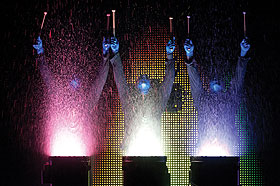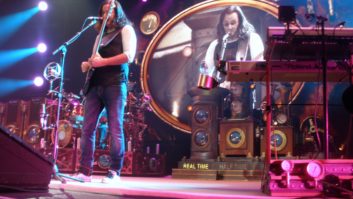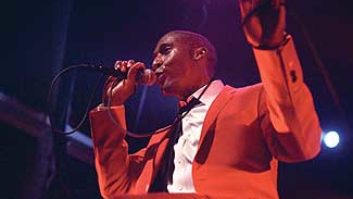
Photos: Steve Jennings
You’re never really quite sure what to expect from a Blue Man Group performance. It’s a visual experience, with numerous antics onstage to draw the eye—tickers displaying political messages; commentary on social media and human interactions; directions for the audience; flashing-lights costumes; very large inflated balls bouncing around the hall. And for those seeing their current tour—which is happening simultaneously in a number of cities—you get the best of all “Blue Man” worlds, a “greatest hits,” if you will. From their iconic “three guys pounding on bottom-lit oil cans” splashing colored paint on every down stroke, to booty-shaking hits from their album The Complex, to striking their mallets on instruments created from PVC piping, the Blue Men enthrall their audience.
And while it is heavily visual, music creates the coherency from section to section. It’s a theatrical performance, though front-of-house engineer David Fleet creates a more club-like vibe for the Blue Men and a four-piece band. Rounding out his mix is a sound design created by Matt Koenig. “The sound design is to always have the Blue Men on top of the mix, with the band supporting them,” Fleet says. “The show goes through a lot of dynamics to try and avoid tiring out the audience members’ ears. There are some very loud pieces, as well as some pieces that are meant to sound almost acoustic with very little in the P.A.”

From left: front-of-house engineer David Fleet, a couple of Blue Men and A2 Harry Platt
At San Francisco’s Golden Gate Theater (where Mix caught the current run), the d&b system includes amps and speakers using a single channel of amplification per box. Towers for the left and right proscenium each contain 16 Q1s, two B4 subs and a Q7 for in-fill. “Offstage of the towers,” Fleet says, “we stack two B2 subs per side with another Q7 offstage of that as an outfill. For the front rows, we use six T10s for stereo front-fills. Above that is a 24-foot truss in which we hang three line arrays. The center array is eight Q1s and the side two arrays are four Q1s per side. There is also a pair of Q10s upstage under the band lofts that double as effects speakers and stage monitors during a few songs.”

THE MAIN EVENT
The sound design also calls for a more tribal-sounding drums for which Fleet uses the Avid Profile’s onboard effects, including reverbs for the drum and percussion kits, as well as an additional reverb for the talking drum and for times when he needs a longer, extra-thick reverb. “I also use an auto-pan plug-in for a few scenes on the zither and drums,” Fleet says. “As for outboard effects, I use an old-school MXR flanger/doubler and a Lexicon PCM91 reverb unit. These are primarily for the Blue Men instruments.”
Those drums are part and parcel of any Blue Man Group show, and Fleet had to enter “Blue Man Boot Camp” to understand the hows and whys. “The best way to describe the way they do things is ‘outside the box,’” Fleet says. “At first, one might think that something is being done so differently that it would almost be wrong, but after seeing how things work for the show, you understand why it is done that way. The most helpful part of this training period was just learning the instruments—getting to know what sounds are coming from where—because they are some unusual instruments.”
Fleet says that much of the attack in reinforcing the instruments comes from the tour’s past runs, learning what works and what doesn’t. For example, miking the Blue Men’s percussive instruments focuses more on putting the mics in the instruments as opposed to on them, using the mics more like a pick-up. “The only mics that are not actually in the instruments are six groups of X/Y formation pairings,” says Fleet. “We then made oversized pop filters for them using plastic bulb cages covered in three layers of pantyhose. This is to minimize the slap of this instrument. For the drums, we don’t like to have a lot of ring to them; we like them more on the dead side, but without removing all of the drum’s tone. Each drum has a note and must be heard to mesh with the other drums. They also should not have too much attack and should sound a little dark.”
A LITTLE HELP FROM THE BAND
The Blue Men are accompanied in their sonic quests by a four-piece band—situated upstage in lofts—comprising drums, percussion, zither/guitar and a stick player who also doubles on bass guitar. Fleet gives the band 16 sends from the Profile to their Aviom Personal Mixing Systems, which they can then mix however they choose. The Blue Men’s mixes are primarily audience mics with not too much direct signal sent to them. All string instruments have amps and speaker cabinets upstage that are stereo-miked as well as DI’d. The drums are individually close-miked with a pair of overheads on each kit. The entire band and the Blue Men are on custom dual-driver Westone molds; all receiver packs are Sennheiser EK300s.
With the band, Blue Men instruments rolling on and offstage, playback, effects and more happening within the hour-and-half set, Fleet has his hands full keeping the mix clear, clean and at a club-like level without being too brash, as the audience makeup often has small children and seniors. However, Fleet mixes more in a rock vein rather than the line mixing seen in most theater shows. “Although this show is louder than average, we strive to give every seat a comfortable level in which to enjoy the show,” says Fleet. “We also supply ear plugs for the audience. I try to make sure that everyone who comes to see the Blue Man Group leaves with a smile from ear to ear.”



